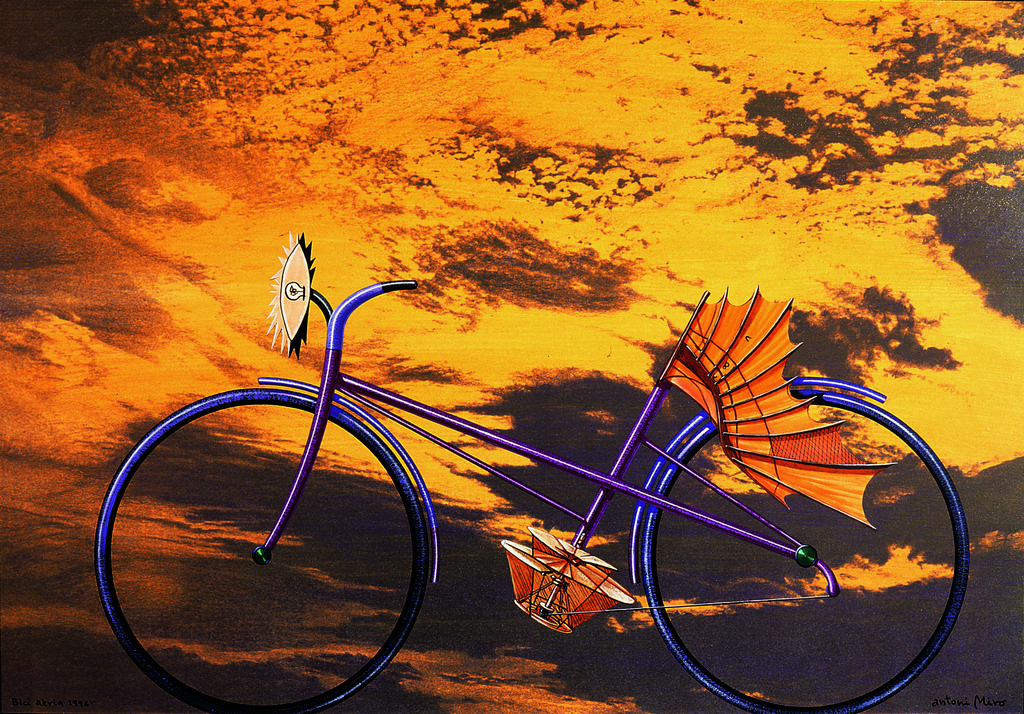Bici aèria (Aerial bicycle)
This is one of the works in the “Vivace” series that shows most similarities with the foregoing “Paint Painting” series. The work reveals “a problem of an eco-social nature” which, as Blasco Carrascosa states, “stems from Man’s lack of awareness of his relationship with the environment”. Yet the artist creates ‘another reality’ which surprises the viewer and uses iconic symbols lifted from canonic art through the lense of new expressive resources. As José María Iglesias stressed in relation to this and earlier series, the composition of his works using disconnected fragments does not correspond with the previous use of collage, “yet the composition does reflect a collage-like mentality”. Imbued with this course of action, he constructs this peculiar bike, which (as in the rest of the series) should be seen as a paradigm of environmental sustainability.
The bike (shown from the side) appears to be supported by the bottom edge of the image, freeing the top half of the canvas. It is set against an intense yellow-lit sky dappled with wind-blown clouds. It is well-known that the sun is the source of all our energy and, therefore, is also what drives wind energy, which is one of the paradigms of environmental sustainability. This bike is designed to cross the skies propelled, given its lightness, by the wind that makes its wings flap. It symbolises a desire for a proper relationship with the environment. Its structural frame, made from slender, magenta-coloured tubes, with some details in blue and green tones, is attached without spokes to black wheels that seem to have no need to turn in order to propel a movement that is completely suitable for the preservation of nature.
Allusions are made to Leonardo (personifying scientific progress) and Picasso (personifying social commitment). Both seem necessary to stop Mankind taking the path to environmental destruction. Thus the Renaissance artist furnishes the means and the Cubist artist the direction required to achieve legitimate goals. One of Leonardo’s flying machines takes the place of a driving force, placed where the pedals are, also fed by the motion of one of the bike’s wings. His ornithopters are used as an example of the quest for solutions by examining animal physiology. Yet this, or any other invention to solve the problem, becomes automatically appropriate given the huge size and importance of the problem and its urgency.
Hence the need to pin down the challenge and encourage everyone to meet it. All one has to do is to set the right course — a task apparently assigned to the Picassian element used here. As we know, there are only two elements that provide light in the metaphorical approach of Guernica’s dramatic scene: an oil lamp and a bare incandescent bulb. The oil lamp is held by a woman (a mother, symbolising Spain’s Second Republic) who both suffers and desperately shows the horrors endured by the bombed town. The bulb is both an allusion to the sun and to the all-seeing eye from which nothing can escape, and also to the risks linked to technological advancement. The Guernica lightbulbs-eye is used in Miró’s picture in an ironic transposition. In Picasso’s work, it lights or witnesses the scene of terror from above, but in Miro’s approach, it is displaced and put at the service of a flying bicycle to light its way and reveal distant horizons. The eye/bulb also provides the bicycle with sight, turning the bike into a kind of mechanical Cyclops.
Both references — the chosen element from Picasso`s Guernica and Leonardo’s flying machines — are incorporated into the painting with plastic literality, as in a collage, without compositional or pictorial changes. Both conserve the features of the originals — the shape of the filament in Picasso’s bulb and the letters of the descriptive legend and stripes on Leonardo’s flying machine. The way of alteration takes another form, namely that this appropriation changes the size and positioning of the elements in order to partially reflect their original purposes and create new ones at the same time.
Santiago Pastor Vila
